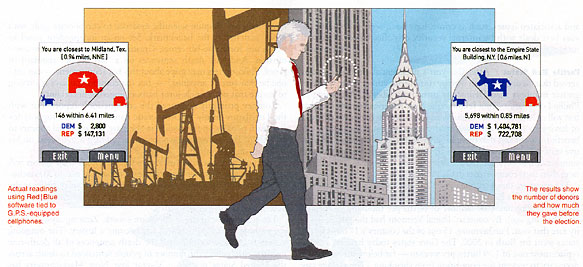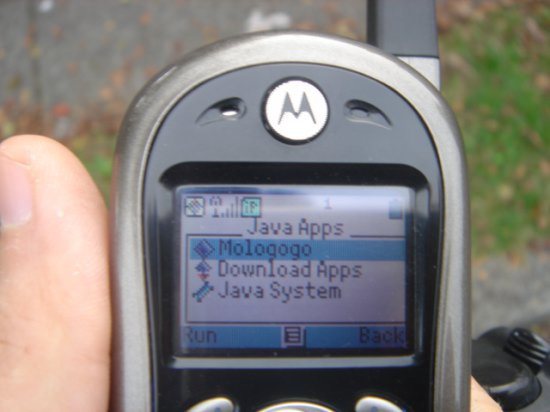About Mologogo
The tale of Chuck, Jason, and a whole bunch of people within medium-earth-orbit view.
In late August of 2005 — practically before the beginning of time, at least as far as mobile technology is concerned — Chuck bought a relatively expensive GPS enabled phone (Blackberry 7250) to engage his growing fascination with location aware applications. He came up with the idea of a homegrown app to send the data up to a database and show it on Google Maps.

Jason had been already long obsessed with developing Java-based cellphone applications, and achieved geek-blog notoriety with the release of a phone and GPS app showcasing campaign contributions for the US 2004 Presidential election. Dusting off old code and older math, the release of Google Maps proved intriguing, and promising -- with the twinkle of developing truly useful and affordable location-based applications. But just a bit too much for one code monkey to tackle.
Chuck found Jason. Immediately intrigued, they furiously coded a client and a server and the first points were mapped. But something seemed perilously wrong, as their location seemed to be impossibly close together -- "Must be a math error," mused Chuck. "Damn curve of the earth," whined Jason. Only then did they realize that they lived in the same town, .0056 longitude and .018 latitude apart. Some would call it fate. Some would say it's just geosynchronous.
Later that week Chuck bought a $60 Boost Mobile "pay as you go" phone on the hunch that it could run the app. It did, and the realization came, this miraculous satellite technology was available and affordable to pretty much anyone, not to mention totally fun. Shortly thereafter "Mologogo" (named for Mobile Location, uh, Go! Go!) was born in October 2005, and users quickly jumped on board. The blogs caught on, the press took a closer look, and Simon coded up a version for Windows Mobile smart phones.

Chuck and Jason burned the midnight oil, and ignored their lovely (and patient) wives and children on weekends to pursue the goal of popularizing location based services. With millions of waypoints recorded along the way, and tens of thousand really awesome registered users, Mologogo became a genuine home-grown, earth-bound, internet phenomenon.
Before long, the smart phone revolution took place, and cheap feature phones that could do GPS became as silly as carrying a separate music player or a digital camera. But even while location apps roared ahead (with most fizzling out eventually), it was clear that there remains a need for simple, extendable location functionality -- and Mologogo still scratches the itch for a high-functionality and low-creepiness product that helps you connect with your friends in the real world.
In late August of 2005 — practically before the beginning of time, at least as far as mobile technology is concerned — Chuck bought a relatively expensive GPS enabled phone (Blackberry 7250) to engage his growing fascination with location aware applications. He came up with the idea of a homegrown app to send the data up to a database and show it on Google Maps.

Jason had been already long obsessed with developing Java-based cellphone applications, and achieved geek-blog notoriety with the release of a phone and GPS app showcasing campaign contributions for the US 2004 Presidential election. Dusting off old code and older math, the release of Google Maps proved intriguing, and promising -- with the twinkle of developing truly useful and affordable location-based applications. But just a bit too much for one code monkey to tackle.
Chuck found Jason. Immediately intrigued, they furiously coded a client and a server and the first points were mapped. But something seemed perilously wrong, as their location seemed to be impossibly close together -- "Must be a math error," mused Chuck. "Damn curve of the earth," whined Jason. Only then did they realize that they lived in the same town, .0056 longitude and .018 latitude apart. Some would call it fate. Some would say it's just geosynchronous.
Later that week Chuck bought a $60 Boost Mobile "pay as you go" phone on the hunch that it could run the app. It did, and the realization came, this miraculous satellite technology was available and affordable to pretty much anyone, not to mention totally fun. Shortly thereafter "Mologogo" (named for Mobile Location, uh, Go! Go!) was born in October 2005, and users quickly jumped on board. The blogs caught on, the press took a closer look, and Simon coded up a version for Windows Mobile smart phones.

Chuck and Jason burned the midnight oil, and ignored their lovely (and patient) wives and children on weekends to pursue the goal of popularizing location based services. With millions of waypoints recorded along the way, and tens of thousand really awesome registered users, Mologogo became a genuine home-grown, earth-bound, internet phenomenon.
Before long, the smart phone revolution took place, and cheap feature phones that could do GPS became as silly as carrying a separate music player or a digital camera. But even while location apps roared ahead (with most fizzling out eventually), it was clear that there remains a need for simple, extendable location functionality -- and Mologogo still scratches the itch for a high-functionality and low-creepiness product that helps you connect with your friends in the real world.